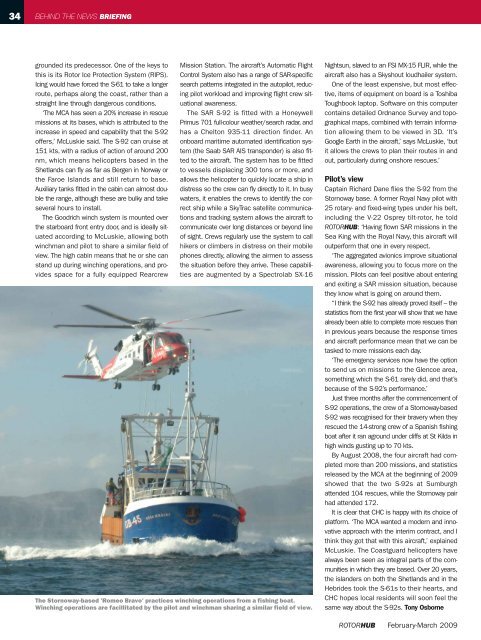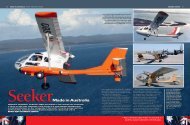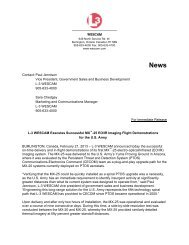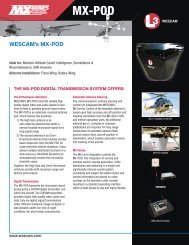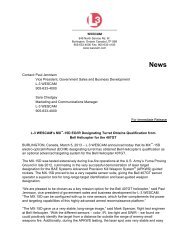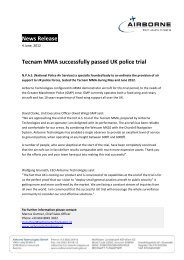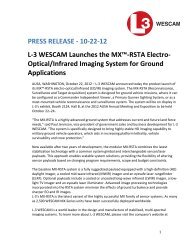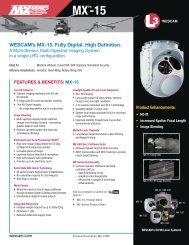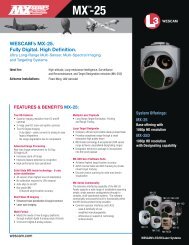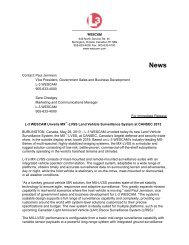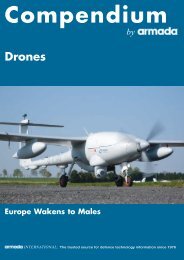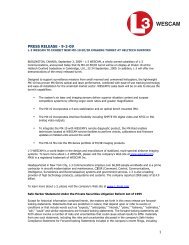SAR S-92 The MCA's new workhorse - Wescam
SAR S-92 The MCA's new workhorse - Wescam
SAR S-92 The MCA's new workhorse - Wescam
- No tags were found...
Create successful ePaper yourself
Turn your PDF publications into a flip-book with our unique Google optimized e-Paper software.
34BEHIND THE NEWS BRIEFINGgrounded its predecessor. One of the keys tothis is its Rotor Ice Protection System (RIPS).Icing would have forced the S-61 to take a longerroute, perhaps along the coast, rather than astraight line through dangerous conditions.‘<strong>The</strong> MCA has seen a 20% increase in rescuemissions at its bases, which is attributed to theincrease in speed and capability that the S-<strong>92</strong>offers,’ McLuskie said. <strong>The</strong> S-<strong>92</strong> can cruise at151 kts, with a radius of action of around 200nm, which means helicopters based in theShetlands can fly as far as Bergen in Norway orthe Faroe Islands and still return to base.Auxiliary tanks fitted in the cabin can almost doublethe range, although these are bulky and takeseveral hours to install.<strong>The</strong> Goodrich winch system is mounted overthe starboard front entry door, and is ideally situatedaccording to McLuskie, allowing bothwinchman and pilot to share a similar field ofview. <strong>The</strong> high cabin means that he or she canstand up during winching operations, and providesspace for a fully equipped RearcrewMission Station. <strong>The</strong> aircraft’s Automatic FlightControl System also has a range of <strong>SAR</strong>-specificsearch patterns integrated in the autopilot, reducingpilot workload and improving flight crew situationalawareness.<strong>The</strong> <strong>SAR</strong> S-<strong>92</strong> is fitted with a HoneywellPrimus 701 full-colour weather/search radar, andhas a Chelton 935-11 direction finder. Anonboard maritime automated identification system(the Saab <strong>SAR</strong> AIS transponder) is also fittedto the aircraft. <strong>The</strong> system has to be fittedto vessels displacing 300 tons or more, andallows the helicopter to quickly locate a ship indistress so the crew can fly directly to it. In busywaters, it enables the crews to identify the correctship while a SkyTrac satellite communicationsand tracking system allows the aircraft tocommunicate over long distances or beyond lineof sight. Crews regularly use the system to callhikers or climbers in distress on their mobilephones directly, allowing the airmen to assessthe situation before they arrive. <strong>The</strong>se capabilitiesare augmented by a Spectrolab SX-16<strong>The</strong> Stornoway-based 'Romeo Bravo' practices winching operations from a fishing boat.Winching operations are facillitated by the pilot and winchman sharing a similar field of view.Nightsun, slaved to an FSI MX-15 FLIR, while theaircraft also has a Skyshout loudhailer system.One of the least expensive, but most effective,items of equipment on board is a ToshibaToughbook laptop. Software on this computercontains detailed Ordnance Survey and topographicalmaps, combined with terrain informationallowing them to be viewed in 3D. ‘It’sGoogle Earth in the aircraft,’ says McLuskie, ‘butit allows the crews to plan their routes in andout, particularly during onshore rescues.’Pilot’s viewCaptain Richard Dane flies the S-<strong>92</strong> from theStornoway base. A former Royal Navy pilot with25 rotary- and fixed-wing types under his belt,including the V-22 Osprey tilt-rotor, he toldROTORHUB: ‘Having flown <strong>SAR</strong> missions in theSea King with the Royal Navy, this aircraft willoutperform that one in every respect.‘<strong>The</strong> aggregated avionics improve situationalawareness, allowing you to focus more on themission. Pilots can feel positive about enteringand exiting a <strong>SAR</strong> mission situation, becausethey know what is going on around them.“I think the S-<strong>92</strong> has already proved itself – thestatistics from the first year will show that we havealready been able to complete more rescues thanin previous years because the response timesand aircraft performance mean that we can betasked to more missions each day.‘<strong>The</strong> emergency services now have the optionto send us on missions to the Glencoe area,something which the S-61 rarely did, and that’sbecause of the S-<strong>92</strong>’s performance.’Just three months after the commencement ofS-<strong>92</strong> operations, the crew of a Stornoway-basedS-<strong>92</strong> was recognised for their bravery when theyrescued the 14-strong crew of a Spanish fishingboat after it ran aground under cliffs at St Kilda inhigh winds gusting up to 70 kts.By August 2008, the four aircraft had completedmore than 200 missions, and statisticsreleased by the MCA at the beginning of 2009showed that the two S-<strong>92</strong>s at Sumburghattended 104 rescues, while the Stornoway pairhad attended 172.It is clear that CHC is happy with its choice ofplatform. ‘<strong>The</strong> MCA wanted a modern and innovativeapproach with the interim contract, and Ithink they got that with this aircraft,’ explainedMcLuskie. <strong>The</strong> Coastguard helicopters havealways been seen as integral parts of the communitiesin which they are based. Over 20 years,the islanders on both the Shetlands and in theHebrides took the S-61s to their hearts, andCHC hopes local residents will soon feel thesame way about the S-<strong>92</strong>s. Tony OsborneROTORHUB February-March 2009


